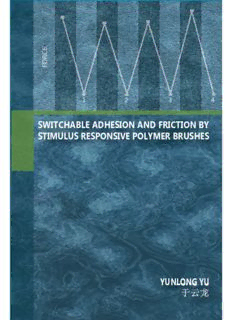
switchable adhesion and friction by stimulus responsive polymer brushes yunlong yu PDF
Preview switchable adhesion and friction by stimulus responsive polymer brushes yunlong yu
EEEEEEEEEE CCCCCCCCC RRRRRRR OOOOOOOOOOOO FFFFFF 1 2 3 4 SWITCHABLE ADHESION AND FRICTION BY STIMULUS RESPONSIVE POLYMER BRUSHES YUNLONG YU Switchable Adhesion and Friction by Stimulus Responsive Polymer Brushes Yunlong Yu 2017 Graduation committee Chairman Prof.dr.ir.J.W.M.Hilgenkamp UniversityofTwente Promotor Prof.dr.G.J.Vancso UniversityofTwente Assistant-promotor Dr.S.J.A.deBeer UniversityofTwente Members Prof.dr.X.Zeng ShanghaiAdvancedResearchInstitute, ChineseAcademyofSciences Dr.A.C.C.deCarvalhoEsteves EindhovenUniversityofTechnology Prof.dr.M.M.A.E.Claessens UniversityofTwente Prof.dr.J.J.L.M.Cornelissen UniversityofTwente Dr.W.M.deVos UniversityofTwente The research described in this Thesis was carried out in the Materials Science and Technology of Polymers (MTP) group, in the MESA+ Institute for Nanotechnology, and in the Faculty of Science and Technology (TNW) of the University of Twente. This research was supported by the China Scholarship Council (CSC) and by the Netherlands OrganizationforScientificResearch(NWO). Title:SwitchableAdhesionandFrictionbyStimulusResponsivePolymer Brushes Copyright©2017,YunlongYu,Enschede,theNetherlands All rights reserved. No part of this Thesis may be reproduced or transmitted by print, photocopyoranyothermeanswithoutpriorwrittenpermissionoftheauthor. ISBN: 978-90-365-4280-7 DOI: 10.3990/1.9789036542807 Cover:designedbyGR-Artworks-GenevièveRietveld PrintedbyIpskampDrukkersinEnschede,theNetherlands SWITCHABLE ADHESION AND FRICTION BY STIMULUS RESPONSIVE POLYMER BRUSHES DISSERTATION to obtain the degree of doctor at the University of Twente, on the authority of the rector magnificus, prof. dr. T.T.M. Palstra, on account of the decision of the graduation committee, to be publicly defended on Wednesday, 11th of January 2017, at 14:45h by Yunlong Yu born on 26th of October, 1984 in Shandong, P. R. China This dissertation has been approved by: Promotor: Prof. dr. G. J. Vancso Assistant-promotor: Dr. S.J.A. de Beer Contents 1.GeneralIntroduction.................................................................................................................1 1.1Introduction.............................................................................................................................1 1.2ContentofthisThesis............................................................................................................2 1.3References...............................................................................................................................3 2.SwitchableAdhesionandFrictionbyStimulusResponsivePolymers..........................5 2.1Polymerbrushes......................................................................................................................5 2.2Surface-initiatedatomtransferradicalpolymerization(SI-ATRP).................................6 2.3Adhesion,adhesionhysteresisandfriction.........................................................................7 2.4Atomicforce microscopy(AFM).........................................................................................8 2.5Stimulusresponsivepolymers..............................................................................................9 2.5.1Temperature...................................................................................................................10 2.5.2Co-(non-)solvency.........................................................................................................11 2.5.3pHandsaltconcentration.............................................................................................12 2.5.4Otherandmulti-stimuli................................................................................................12 2.6Switchableadhesion.............................................................................................................13 2.6.1Adhesionbetweenchemicallyidenticalpolymer films...........................................13 2.6.2Theadhesionbetweenpolymerfilmsandchemicallydifferentcountersurfaces15 2.7Switchablefriction...............................................................................................................16 2.7.1Frictionbetweenchemicallyidenticalpolymerfilms..............................................17 2.7.2Frictionbetweenpolymerfilmsandchemicallydifferentcountersurfaces.........17 2.8Relationbetweenfrictionandadhesion/adhesionhysteresis.........................................19 2.8.1Relationbetweenfrictionandadhesion.....................................................................21 2.8.2Relationbetweenfrictionandadhesionhysteresis...................................................21 2.9Summary................................................................................................................................22 2.10References...........................................................................................................................24 3.StretchingofCollapsedPolymersCausesanEnhancedDissipativeResponseof PNIPAMBrushesneartheirLCST..........................................................................................31 3.1Introduction...........................................................................................................................32 3.2MaterialsandMethods.........................................................................................................33 3.2.1Materials.........................................................................................................................33 3.2.2Preparationofpolymerbrushes...................................................................................34 3.2.3Characterization.............................................................................................................35 3.3ResultsandDiscussion........................................................................................................38 3.4Conclusions...........................................................................................................................47 II Contents 3.5References.............................................................................................................................47 4.TunableFrictionbyEmploymentofCo-non-solvencyofPNIPAMBrushes.............51 4.1Introduction...........................................................................................................................52 4.2MaterialsandMethods.........................................................................................................53 4.2.1Materials.........................................................................................................................53 4.2.2Brushpreparationandcharacterization......................................................................54 4.3ResultsandDiscussion........................................................................................................55 4.4Conclusions...........................................................................................................................62 4.5Appendix................................................................................................................................63 4.6References.............................................................................................................................67 5.Pickup,MoveandRelease ofNanoparticlesUtilizingCo-non-solvencyofPNIPAM Brushes............................................................................................................................................71 5.1Introduction...........................................................................................................................72 5.2MaterialsandMethods.........................................................................................................73 5.2.1Materials.........................................................................................................................73 5.2.2Colloidalprobepreparation.........................................................................................74 5.2.3Brushcharacterization..................................................................................................74 5.2.4AFMadhesionforce measurements...........................................................................75 5.2.5Particletransfermeasurements....................................................................................75 5.3ResultsandDiscussion........................................................................................................75 5.4Conclusions...........................................................................................................................80 5.5Appendix................................................................................................................................81 5.6References.............................................................................................................................86 6.Cosolvency-InducedSwitchingoftheAdhesionbetweenPoly(methylmethacrylate) Brushes............................................................................................................................................89 6.1Introduction...........................................................................................................................90 6.2MaterialsandMethods.........................................................................................................92 6.2.1Materials.........................................................................................................................92 6.2.2Preparationofpolymerbrushes...................................................................................92 6.2.3Characterization.............................................................................................................93 6.3ResultsandDiscussion........................................................................................................95 6.4Conclusions...........................................................................................................................99 6.5References...........................................................................................................................100 7.SubstantiallyEnhancedStabilityAgainstDegraftingofZwitterionicBrushesby UtilizingPGMA-basedMacro-initiators...............................................................................103 7.1Introduction.........................................................................................................................104 7.2MaterialsandMethods.......................................................................................................106 Contents III 7.2.1Materials.......................................................................................................................106 7.2.2Methods........................................................................................................................106 7.2.3Characterization...........................................................................................................107 7.2.4Stabilitytest..................................................................................................................110 7.3ResultsandDiscussion......................................................................................................110 7.4Conclusions.........................................................................................................................115 7.5Appendix..............................................................................................................................116 7.6Reference.............................................................................................................................121 8.FirstResultsandOutlookon:SpecificAnionEffectsontheHydrationand TribologicalpropertiesofZwitterionicPMPCBrushes....................................................125 8.1Introduction.........................................................................................................................126 8.2MaterialsandMethods.......................................................................................................128 8.2.1Materials.......................................................................................................................128 8.2.2SynthesisofPGMA-PMPCbrush............................................................................128 8.2.3Characterization...........................................................................................................128 8.2.4Swellingratiomeasurement.......................................................................................129 8.3ResultsandDiscussion......................................................................................................130 8.4Outlook................................................................................................................................134 8.5References...........................................................................................................................135 Summary.......................................................................................................................................137 Samenvatting................................................................................................................................141 Acknowledgements.....................................................................................................................143 CurriculumVitae........................................................................................................................145 Chapter 1 General Introduction 1.1 Introduction Stimulus-responsive polymers1 are defined as “polymers that undergo relatively large and abrupt, physical or chemical changes in response to small modifications in the environmental conditions”. Recently, there has been quickly growing interest in developing ‘smart’ surface-coatings by using stimulus-responsive polymers, while they can be applied for varying the surface wettability2 and in drug delivery,3 chemical-sensing4 and tribology control.5 In these applications, the conformational state and/or the chemical structure of the polymers is strongly altered due to the adjustment in the surroundings, such as temperature,6 light radiation7 or electric field,8 which results in a change in the macroscopic propertiesofthesurfacecoating. There are different methods to decorate a surface with polymers. Polymers can be physisorbed9 or covalently bonded to the surface via their side-chains.10 Moreover, hydrogels can be prepared, which can swell by solvent absorption by many times their initial size.11 Furthermore, so-called polymer brushes can be formed.12 In a polymer brush, the polymers are attached with one end to the surface at a density that is high enough for the polymers to stretch away from the surface.13 The latter is caused by steric hindrance by the surrounding polymers and can be enhanced by solvent absorption when the brush is keptinagoodsolvent. In this Thesis, we will present different polymer brush coatings that have been used to control adhesion and friction. When polymers are triggered to change their conformation or chemical structure by an external stimulus, the interaction, e.g. the van der Waals forces, electrostatic forces, forces due to hydrogen bonding etc., between surfaces that are coated with these polymers will also change. Generally, when a stimulus causes the effective interaction to become more attractive, the surfaces will be more strongly bound and make more intimate contact, such that adhesion and friction will increase, while the opposite is true when the stimulus results in more repulsive interactions.5b, 6b, 14 However, as we will discuss in more detail in this Thesis, there are important exceptions for which the inverse can occur.12b,15 In our research we systematically study the relation between the degree of solvation of the macromolecules in the brush and the friction and adhesion. Our results show that the relation between brush swelling and its tribomechanical properties is rather complex, and that it can depend on the specific interactions in the contact. Our careful characterization will allow for the development of e.g. smart tweezers5e and gloves,16 pick upandreleasetools.17
Description: